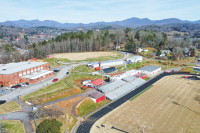Simple living
By Kathleen Lamont
Have you heard?
The recent marriage of sustainable food production and big business is on the rocks.
They’ve been together for nearly 10 years now, and everyone said it would never last. It’s been all over the news lately like so much tabloid gossip. The most recent cover story was in BusinessWeek: The Organic Myth – Pastoral ideals are getting trampled as organic food goes mass market.
It all started in 1997 when Mars, the candy company, purchased Seeds of Change, the organic seed producer, in order to launch a range of quality organic convenience foods worldwide. From then on it was Katy bar the door. Big business began closely watching this $14 billion-a-year industry and corporation after corporation began buying up the small privately held organic farm or business in order to feed its bottom line.
Part of the problem started decades earlier, sometime around the end of World War II when production farming began to grow and cattle feedlots began to sprout up like chickweed in the spring. Feedlot cattle stand around all day in their manure eating a diet of grain that happens to turn a cow’s rumen into an ideal habitat for E. coli 0157:H7. We did not know this strain of E. coli, responsible for the recent spinach fiasco, before 1982. (Please note that E. coli 0157:H7 cannot survive long in cattle living on grass; cows are vegetarian by nature.)
Food poisoning has always been with us, but not since we started processing our food in so few plants did we become a target for nationwide outbreaks.
Today four companies slaughter 80 percent of America’s beef, 75 percent of the precut salads are processed by just two companies, and 30 percent of the milk by one company.
But hey, you can get more cluck for your buck on a feedlot, and the USDA inspectors can work more efficiently at meat processing plants — which are highly vulnerable to contamination — if they can inspect 400 carcasses per day as opposed to one or two at a smaller facility. It has come down to this: the industrialized way we farm and the highly centralized way we process our food is endangering our health.
Erstwhile farm poet Wendell Berry once wrote that when we took animals off farms and put them onto feedlots, we had, in effect, taken an old solution — the one where crops feed animals and animals’ waste feeds crops — and neatly divided it into two new problems: a fertility problem on the farm, and a pollution problem on the feedlot.
I recently saw a private viewing of the movie, “An Inconvenient Truth,” where Al Gore suggests we reduce our energy use by 25 percent to combat global warming. There were about 50 people there, all middle class, almost all senior citizens, and I would imagine that most of them are like the other 300 million of us on the planet. Global warming and what we can do to lessen its effect is not something they consider in their day-to-day lives.
Where to start? Do I have to change my lifestyle? On the contrary, it’s all behavior modification, and if the fire to make a difference burns in your belly, then you will. Which brings me to the question being begged by this whole global warming thing: How do we get the average Joe to burn with passion for this issue? Typically, not until the alligator is nipping at his heels. The truth is it shouldn’t matter. Honoring the earth that feeds and clothes us is the least we can do for our Mother.
And herein lies the difference between the farmer with 20 acres who has chosen to farm in a sustainable fashion and industrialized production farming. For the small farmer, it’s in his heart. The small-scale farmer tends to honor his soil and leaves it healthier than he found it while agribusiness is more concerned about tending to its stockholders.
So if you buy lettuce from the Central Valley in California, you have added to the problem of global warming by voting with your dollars to have a truck drive more than 3,000 miles cross country, polluting all the way. Instead, vote with your dollars and tell them you are not willing to support this folly. Take responsibility for your buying decisions and get your lettuce from the tailgate market, or better still, grow it yourself. Whether global warming and buying local is connected or not, in the end what will ultimately sustain us will be locally provided food, goods, and services from local town folk.
Ten things you can do:
• Take your own shopping bags into every store, and while you’re at it, take a shopping cart in with you. You’re walking that way anyway.
• Use plastic bowl covers instead of plastic wrap.
• Replace paper napkins with cloth napkins.
• Use waxed paper sandwich bags.
• Collect rainwater.
• Use rags instead of paper towels.
• Hang your clothes out on a clothesline.
• Buy things you can reuse or fix instead of tossing.
• Grow a victory garden.
• Compost kitchen scraps and yard waste. (Save our landfills!)
(Kathleen Lamont is a local organic gardener and owner of www.BacktoBasicsNC.com. She can be reached at This email address is being protected from spambots. You need JavaScript enabled to view it..)





